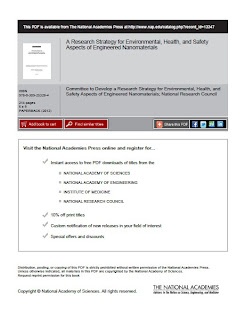Nanotechnology relies on the ability to design, manipulate, and manufacture materials at the nanoscale. The emerging field of nanotechnology has the potential to lead to substantial advances in many sectors—energy, medicine, electronics, and clean technologies, for example—while contributing to substantial economic growth. Engineered nanomaterials (ENMs) are already in industrial and consumer products, including drug-delivery systems, stain-resistant clothing, solar cells, cosmetics, and food additives. It is the nanoscale-specific properties of ENMs (for example, their electronic, optical, or chemical-reactive qualities) that are key to research and commercial applications.
Read complete report here.
The nanotechnology sector, which generated about $225 billion in product sales in 2009, is predicted to expand rapidly over the next decade with the development of new technologies that have new capabilities. The increasing production and use of ENMs may lead to greater exposures of workers, consumers, and the environment, and the unique scale-specific and novel properties of the materials raise questions about their potential effects on human health and the environment. In light of the rising use of ENMs, this report was motivated by the need for a research strategy to address critical gaps in knowledge related to the unique properties and environmental, health, and safety (EHS) risks of ENMs.
Major challenges in developing such a strategy include
- Great diversity of nanomaterial types and variants.
- Lack of capabilities to monitor rapid changes in current, emerging, and potential ENM
applications and to identify and address the potential consequences for EHS risks.
- Lack of standard test materials and adequate models for investigating EHS risks, leading to
great uncertainty in describing and quantifying nanomaterial hazards and exposures.
To address these challenges, the Environmental Protection Agency (EPA) asked the National Research Council to perform an independent study to develop and monitor the implementation of an integrated research strategy on EHS risks of ENMs. In response to EPA’s request, the National Research Council convened the Committee to Develop a Research Strategy for Environmental, Health, and Safety Aspects of Engineered Nanomaterials, which prepared this report. The committee was charged to create a conceptual framework for EHS-related research, to develop a research plan with short-term and long-term research priorities, and to estimate resources needed to implement the research plan. In a subsequent report, the committee will evaluate research progress.
In this report, the committee presents a strategic approach for developing the science and research infrastructure needed to address uncertainties regarding the potential EHS risks of ENMs. This approach begins with a discussion of the need for a research strategy. The committee next describes a new conceptual framework that structures its approach, focusing on emerging materials that may pose unanticipated risks, and on the properties of ENMs and their influence on hazards and exposure. The committee then identifies critical research gaps reflecting the elements of the framework, and the tools needed for addressing these gaps. Together with the conceptual framework and the identified gaps and tools, the committee develops the research portfolio, identifying where changes in course are needed, and where additional cross-cutting research would add value. Resources needed to implement the research priorities are identified. Last, the committee discusses the need for mechanisms to ensure implementation of the research strategy and evaluation of research progress that will be conducted in the subsequent report.
The nanotechnology sector, which generated about $225 billion in product sales in 2009, is predicted to expand rapidly over the next decade with the development of new technologies that have new capabilities. The increasing production and use of ENMs may lead to greater exposures of workers, consumers, and the environment, and the unique scale-specific and novel properties of the materials raise questions about their potential effects on human health and the environment. In light of the rising use of ENMs, this report was motivated by the need for a research strategy to address critical gaps in knowledge related to the unique properties and environmental, health, and safety (EHS) risks of ENMs.
Major challenges in developing such a strategy include
- Great diversity of nanomaterial types and variants.
- Lack of capabilities to monitor rapid changes in current, emerging, and potential ENM
applications and to identify and address the potential consequences for EHS risks.
- Lack of standard test materials and adequate models for investigating EHS risks, leading to
great uncertainty in describing and quantifying nanomaterial hazards and exposures.
To address these challenges, the Environmental Protection Agency (EPA) asked the National Research Council to perform an independent study to develop and monitor the implementation of an integrated research strategy on EHS risks of ENMs. In response to EPA’s request, the National Research Council convened the Committee to Develop a Research Strategy for Environmental, Health, and Safety Aspects of Engineered Nanomaterials, which prepared this report. The committee was charged to create a conceptual framework for EHS-related research, to develop a research plan with short-term and long-term research priorities, and to estimate resources needed to implement the research plan. In a subsequent report, the committee will evaluate research progress.
In this report, the committee presents a strategic approach for developing the science and research infrastructure needed to address uncertainties regarding the potential EHS risks of ENMs. This approach begins with a discussion of the need for a research strategy. The committee next describes a new conceptual framework that structures its approach, focusing on emerging materials that may pose unanticipated risks, and on the properties of ENMs and their influence on hazards and exposure. The committee then identifies critical research gaps reflecting the elements of the framework, and the tools needed for addressing these gaps. Together with the conceptual framework and the identified gaps and tools, the committee develops the research portfolio, identifying where changes in course are needed, and where additional cross-cutting research would add value. Resources needed to implement the research priorities are identified. Last, the committee discusses the need for mechanisms to ensure implementation of the research strategy and evaluation of research progress that will be conducted in the subsequent report.
Fonte: Laboratory Equipment

